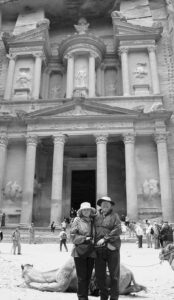
Warner, Linda, and a very tired camel in front of the Treasury at Petra. Indiana Jones had been long gone.
Editor’s Note: At the request of his readers and in memory of Warner M. Montgomery, Ph.D, we will continue to publish his Adventure Travel stories for the time being.
Nena Powell Rice of the S.C. Institute of Archaeology and Anthropology and a fellow member of The Explorers Club, once told me, “If you go to Jordan, you must see Petra. It is the most magnificent historic artifact I have ever seen.” So, on our trip to the Middle East, Linda and I visited Petra, a UNESCO World Heritage Site and one of the New Seven Wonders of the World. We were not disappointed.
Petra was rediscovered in 1812 by a Swiss explorer who dressed as a Bedouin and walked around the Holy Land. It had been a secret place of refuge since biblical times. By the sixth century BC, the red-colored canyon between the Dead Sea and the Arabian Desert was settled by the Nabataeans (a semitic tribe who spoke Aramaic, the language of Jesus). It became a major caravan stop between Europe, Egypt, Arabia, and on to India.
A clever water supply system was built that brought water into the bone dry canyon through an elaborate array of dams, cisterns, and ceramic conduits.
Over the centuries, Petra was dominated by Egyptians, Greeks, Romans, Christian Crusaders, and Muslims plying the trade routes and influencing the Nabataean culture. In his 40 years of wandering, Moses passed through Petra. It is believed that he struck a rock wall with his staff and water came forth. The narrow entrance to Petra is called Wadi Musa (Arabic for Valley of Moses).
Into the walls of the sandstone canyon the Nabataeans built tombs, temples, and theaters. They lived in stucco houses on the level plain at the end of the canyon. In 363 an earthquake destroyed most of Petra including the water system, and the city was abandoned. Petra vanished into history until Johann Ludwig Burckhardt, the Swiss explorer, “found” it in 1812.
Linda and I were awestruck by the stark beauty and historical significance of Petra. Our guide attempted to explain the 5,000 tombs and 1,000 monuments we witnessed on that sunny 50-degree Sunday in March 2009.
When we reached the end of the narrow Siq (gorge), the sight of the Treasury shocked us to our very core. This elaborate Greek-styled burial chamber was carved out of a sandstone rock face around 100 BC. It was the featured element in Indiana Jones and the Last Crusade. Further down the canyon was the Monastery (actually another tomb) and the Roman-styled Theater, equally fascinating structures.
We walked and gawked for four hours, stopping once for a Coke and salad at a Bedouin café. That evening, back at our hotel, we celebrated with a Turkish bath: steam, luffa rub, wash, massage, and shower. A little luxury never hurts.



Loading Comments